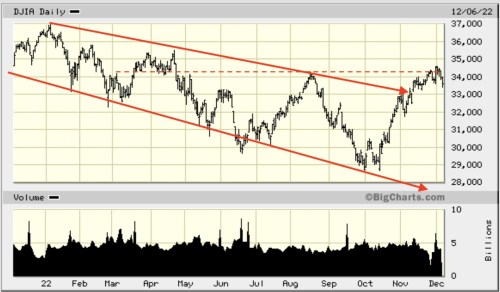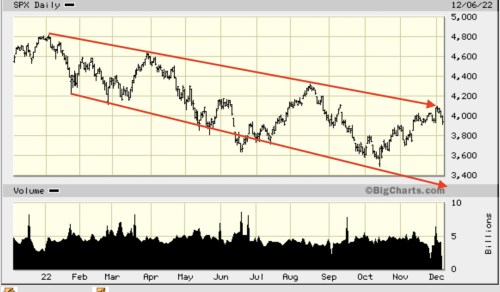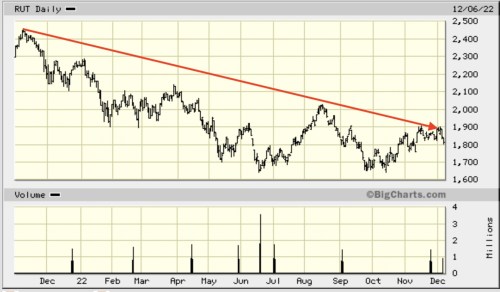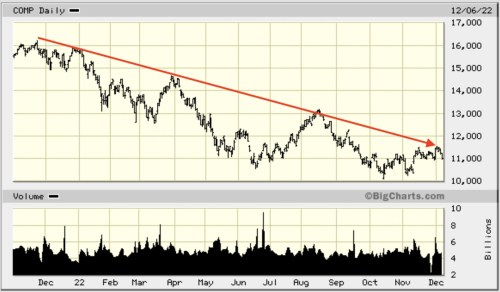It’s important to say when you were wrong, especially if you are prone to point out when you were right. Otherwise, you are just boasting in vain conceit. If you point it out both ways, you are just being factual.
I point out when I was right a lot more on this site than in my personal life, but that is because I want to make clear that the Fed and the financial media are without excuse for not seeing the problems the Fed is going to create and for not reporting on them accurately as they happen. So, far almost no one in the financial media sees it. It is also because I get new readers coming through who have no idea what I’ve predicted and others who forget months down the road (as sometimes even I do) what I said.
My big reason for doing this is to show repeatedly that the Fed’s failings can be seen coming from a great distance off because of how wrong the Fed’s plans are to begin with. If I can readily see them coming and say when they’ll happen, then there is no excuse for the Fed to not see how its plans will fail because they have a lot of experts paid a lot more than I make to set them on the right course; a course that has resulted in disaster after disaster for all of us.
Even Ben Bernanke expansions don’t die a natural death; they are murdered, and Janet Yellen said the Fed holds the gun. There is no excuse for highly paid financial writers not to see the disaster that is coming when we’ve been through these cycles before to the point where they are predictable. Worse, yet, they don’t even seem them AS THEY ARE HAPPENING! And we got a huge load of those happening this year:
The financial experts didn’t see that inflation was growing, even as it was happening last year and this year, much less before it started showing up when I was warning in late 2020 that we were entering a time where the Fed’s money printing would finally start to create inflation because it was being done in a time of shortages and doled out to the masses. They didn’t see that inflation was not transitory, even as it kept rising. They didn’t see that failing to predict inflation’s non-transitory rise would force the Fed to tighten even faster and harder and, therefore, more destructively down the road. They didn’t see that reversing QE and sucking money back out of the monetary system would create problems in the bond market. They didn’t see that the combination of inflation fighting and of bond interest soaring would drive the stock market relentlessly into a bear market by taking away its easy money and giving it competition for yield. They didn’t see ALL SUMMER LONG that there was no way the Fed would pivot back to loose financial policy, even though it was obvious that it would not because it CANNOT legally do so when it sees the job market as strong, leaving the Fed with only one mandate to adhere to — maintaining price stability. So, they all kept believing stocks were going to go back up due to a Fed pivot, even as the money that got pumped into stocks got sucked out the financial system and as the economy that forms the foundation for earnings slowed down. They didn’t see a recession coming as we approached 2022, and they even refused to see one after we had two negative quarters of GDP in the first half of 2022. They didn’t see it because they believed the labor market told a different story and, mostly, because they didn’t want to. That’s because they haven’t seen that a labor market that cannot provide anywhere close to the normal level of labor is not a strong labor market and does not indicate a strong economy, but is a broken labor market; and they didn’t understand the very basic concept that, if the labor market is unable to provide the normal level of PRODUCERS, then it is impossible for the economy to have the normal level of PRODUCTION (GDP); therefore, barring some huge boost in labor efficiency, production must drop, and that IS a recession. Finally, they didn’t see that the government buried the third negative quarter of GDP under a blatantly false inflation number.
All of these things they have missed entirely … and are still missing. And that’s a LOT of MAJOR errors! The Fed and all of its pocket politicians and nearly all the writers in financial media and the banks and the brokers keep stumbling along the same horribly mistaken path, while you know I’ve pointed out all of those pitfalls all along the way and even before the way began, saying when they would show up. It’s important, in my view, to keep pounding that message because, unless people realize how predictably horrid the Fed’s path is, we will keep redoing these rinse-and-repeat cycles as I wrote about in my little ebook in the belief that no one can see these things coming. They can’t be helped. And I don’t want to keep doing them.
2022 has, in fact, been the boldest display of proven Fed error, as well as stock-market error and greed and delusional thinking we’ve seen in decades. And, when it all comes down, they will, again, say, “No one could have seen all of this coming.”
Cruising past the cryptocrisis
One thing I did NOT see coming, though I am not surprised in the slightest that it happened, is the massive cryptocrash. I never predicted this major event because I don’t know much about crypto-currencies. I don’t really understand how they work. They are black boxes to me, and I don’t make predictions about things I don’t understand. They were proclaimed to be this great hedge against a crashing currency, and I never really believed they would be that, but I also didn’t know. Maybe they would.
So, I just stayed out of talking about crypo much because I didn’t want to spend the time it would take to deeply understand it, and I didn’t buy any because I fundamentally don’t trust something that works by invisible math and algos that I don’t begin to comprehend. Fed money is much easier to understand because it doesn’t require people to crack completely useless equations with ever more massive computers to try to get an edge on the other equation miners at ever higher costs of energy consumption, just for establishing the value of the money along pathways I know nothing about.
There seemed to be a lot of nooks and crannies in the etherial electronic synapses that either graft or Ponzi schemes could hide in, but that was just how it looked to me as an outsider not willing to invest the time required to really understand it. So, I stayed out. I don’t fault myself for not seeing things coming that I don’t understand and, and I’m thankful, at the same time, for those who have done well in crypto (so long as they have not taken the path taken by Slippery Sam, the fried bankman of crypto) who have supported my writing along the way.
Time to say I was wrong
Today, however, is one of those days where it is time to say I was clearly wrong in my prediction of an October surprise from the stock market and then wrong again to have doubled down on that when I said the series of waterfall events I said was coming finally got started on the last day of October. Clearly, we didn’t see the stock market ride a chute of waterfalls right away, and I won’t try to justify the error. I was just wrong. I ridiculed Zero Hedge for its unwavering trust in the “Two Michaels” at Morgan Stanley and Bank of America, who predicted the start of a big rally in October. The market went on to complete a full (albeit totally typical) bear-market rally.
The error of my ways will not stop me, however, from saying I think that rally, which many saw as the end of the bear market, was nothing but another bull trap like the one we saw mid-summer and the one that came before that. It was exactly that same thing. As I’ve said, bear markets are notorious for heart-stopping rallies.
The important thing here is that the longer pattern of the bear-market trend is still firmly in place, in spite of the October rally that left me as the only one surprised; and it is that longer trend that reveals the Fed’s errors and the errors of its attempts to correct its errors. Rallies within this now year-long bear market have not stepped outside the trend that is happening due to macro-economic reasons and Fed policy with one exception.
The big, big fail
The exception was the Dow — the only major index that did break out of its trend to recover to its most recent peak. So, let’s start there with the market’s strongest hope of beating me. Here are the trend lines, and you can see the Dow clearly broke through its sloped glass ceiling of the upper trend line.

The Dow not only made a solid breakout above its declining top trend line, but it even feebly attempted a break past major resistance at its last peak (the dotted line). The question that leaves is whether the Dow is capable of continuing a charge that eventually sucks other stocks and the other major indices along in its wake. I am certain that it isn’t. As you can see, the Dow barely broke above the resistance level of beating its last peak, and that breakout appears to have petered right out.
However, my reasons for predicting the bear market will continue to prevail have nothing to do with charts. All of my economic predictions are based on how the Fed’s plan is going to create a wake of destruction and on all the economic factors that are going to continue to grind this market down into THEIR reality. But, I think even chart watchers can see there is pretty sound reason here to think the Dow is done — that it’s done all it can for now. That becomes really clear when you look at how solidly stocks have held within the confines of this bear market in all the other major indices.
First, here’s the S&P 500:

The S&P shows a precisely projected and rigidly confining top line, and the S&P just touched that falling trend again at the start of December as it has done twice before in bear-market rallies, and clearly did not break through. It instantly plunged and is building momentum on its way back down to try to plumb that bottom trend line again, which has not been quite as precisely defined, but is still pretty consistent. If the S&P were to stay within the broad confines of this bear market, then it could still easily go below 3200 on its present downslope, and its move back in that direction right now looks like a waterfall already, as does the Dow’s start back down.
In fact, the last few days already wiped out the post-Powell press that shot stocks up on the glib and utterly hollow basis that Powell said what everyone already knew because he’d already said it — that the Fed will reduce the size of its rate hikes in December, tightening at a slower rate, but will continue to hike to an ultimately higher level. The market got the oxygen it yearned for, even though everyone already knew this, so the Dow made a run past that top bound in pure delirium, but it smashed its head against the ceiling established by its last peak and tumbled quickly back down, looking like it had stunned itself … like this:

Now, that does look like the short waterfalls and rebounding rapids I was talking about for October, except that it didn’t come when I thought we’d see it. The green (in-the-money bar) was the big push as soon as Powell told everyone what everyone already knew about slowing the pace of rate hikes, and the days after (in the red bars) undid all of that. The Dow, the S&P, and the Russell 2000 are all solidly back in the red after the Powell push. So, the attempt to break out of a bear market did not prevail.

Not being such a highly watched and traded chart, the Russell’s more general collection of stocks has not followed as precise of a trend line, but clearly it just maxed out at its uppermost reach, and is now also headed sharply back down.
Finally, the NASDAQ just ducked, too:

Again, the NASDAQ had held a very consistent upper trend line since its ultimate peak a year ago, and it clearly caved in like the others as soon as it came up against that ceiling. As I said, I’m not predicting where the market will go based on charts, but I’m showing there is ample evidence to believe my broader prediction about this market remaining firmly in a bear market that has a lot further to fall remains fully intact so far.
Here are the underlying reasons for my own prediction — a broad and powerful mass of destructive forces:
- Still persistent high inflation that is not easy to kill.
- A Fed forced by its inflation mandate to raise interest rates higher than it recently thought and hold them there longer, giving more time for economic damage to accumulate.
- A Fed sucking money out of the financial system (QT), letting trillions in bonds it had sopped up hit the market when they roll over for refi.
- Rising bond yields due to all of the above with those yields competing against stocks.
- Falling home values due to the Fed’s raising of interest rates that forces prices down to keep payments minimally affordable.
- The loss of all that wealth.
- The precarious nature of an extremely leveraged economy when the cost of credit rises on everyone and everything.
- The economic recession that was already revealed by two down quarters in production that no one wants to acknowledge as a recession.
- A failing economy cannot support earnings growth.
- The loss of jobs the Fed is aiming for as part of its inflation-reduction plan, requiring a lot of economic suppression to get to that point, which will likely cause an overshoot.
- The likelihood of major financial breaks in stocks, bonds, crypto currencies, leveraged debt, interbank loans, business bankruptcies, etc., producing Lehman moments of sudden shock and awe that cause their own cascades due to contagion.
- Continuing plague (Covid) and famines (in many things, not just food) from trade wars, Covid lockdowns, war and sanctions and droughts) monkeying up supply chains.
- Global failures in all the above, not just US failures.
- The panic and loss of confidence that eventually will hit across the globe as these things cascade into failure.
The Fed’s fat fail
The Fed only has SOME control and SOME of the blame in those listed factors, but its engineered recovery from the Great Recession and then from the Covidcrisis was going to fail ultimately because you cannot pump markets up with lots of money and not create high inflation once shortages come, causing people to deploy that money to compete for limited goods. Likewise, you cannot suck the money out that created that “wealth effect” without undoing the wealth effect the free Fed funds created. What goes up must come down when you do the equal and opposite thing that caused the move up in the first place.
You see, it’s really not that hard to predict. You know the schedule of the Fed’s big changes. It’s cause and effect from there. Fed money all goes somewhere to be stored — finds assets to be stored in and pumps up the value of those assets. Remove the money, and it has to come from somewhere as the Fed sucks the foundations of its funny money back out of the economy. A lowering tide lowers all boats. The things that were pumped up the most on the free Fed funds are likely to be the things that fail the most on the way back down.
It’s a rigged economy, so it is going to go as the rigging goes. Don’t fight the Fed on the way up, because they own the money engine. Therefore, don’t be a fool and fight the Fed on the way down. Your boat won’t stay up when the tide goes down. Don’t kid yourself: boats float, they don”t fly.
In a real economy, the Fed would not be doing any manipulation. The stock market would go up when profits looked good and solid and down when they looked to be failing. So, things would make sense. Instead, we all know all investors in the market hinge on every word the Fed gives about what it is going to do with money supply via interest rates, bond purchases, roll-offs, and sales, etc. Therefore, the Fed has created this bizarre world where good economic news means bad news for the market because it means the Fed will stop pumping the easy money, and bad news is good for the market because more free money will be coming. It is truly sick and totally codependent for markets to work in that manner.
It is possible to have a non-manipulated economy even with Fed fiat currency, but that can only happen if you end the Feds’s employment mandate. That mandate is what empowers the Fed to manage the economy, and it is a mandate (and hence a power) the Fed did not originally have. Stay with just the original mandate that the Fed manage its money for zero inflation, and tell your government to stop trying to manipulate the economy with monetary policy via the Fed as the government’s agent. Politicians always like to think they can save the world and can manage the economy better than the daily mess of markets can sort things out on their own. Central planners have been endlessly wrong about that, but planning is power.
The second mandate (jobs creation) gives the Fed enormous power because the Fed must be empowered by the government to do what its mandate requires to spur job growth. End the second mandate, and the Fed would create only as much money as the economy demanded. Too much money, and inflation would rise, forcing the Fed to back off. Too little, and deflation would come, forcing the Fed to make more money. Jobs would do what jobs do based on the economy doing what it does, and the Fed would not be able to rescue the economy at all. Instead, the economy would do what it is going to do for infinite reasons in a true market economy that no one manages, and the Fed would just regulate its money to maintain even value so that its money supply is neither accelerating the economy artificially, nor choking it from overly restricted funds by giving the economy what it needs to transact the business it has to do, scaled to the changing size of the population. All of that can be automatically guided just by homing in on zero inflation.
Politicians believe they can and, therefore, must manage the economy when what they should do is manage the basic rules businesses operate under in order to assure an equal and just playing field for all. They are deluded. Whenever they, and their banker, try to drive the economy into boom times by pumping money, those times inevitably end in major busts … every time … as we saw in 2000, then again in 2008 and then in 2020 after the new big boost that is now collapsing in the Everything Bubble Bust.
This is what central planners do. They are never as smart as they think.
This time it’s going to bust badly because this time, the master muppets pumped up everything all at once, higher than ever before; and Fed funds aren’t going to fix the problems that are now breaking the faked-up recovery apart because Fed funds cannot fix shortages and wars and plagues and because the Fed cannot rush in to help this time anyway because it is mandated to fight inflation until the economy breaks badly enough to crush the jobs market, which will, then, finally trigger the Fed’s second mandate.
This jobs market is the Fed’s big blind spot, because the Fed believes its tightness in in good part from too much demand, which the Fed believes it must curb by cooling the economy, but it is actually just tight from too few laborers to meet normal demand. In a market that currently has 1.7 jobs per participating laborer because people wither willing or able to work are too few, you have to crush a lot of jobs to get to where you start really increasing unemployment because, for now, most people can still shift sideways into one of the other jobs that has been available for months. The economy will fold worse than the Fed thinks because the economy is not what is driving the labor market into tightness. The Fed is misreading economic strength by thinking that is what a tight labor market is showing. Not this time. It’s just a broken labor market that is already taking the economy down to match up with fewer available workers.
We will, however, get there more quickly because the Fed will keep tightening as long as it takes to visibly break the labor market into rising unemployment (even though we already have too few workers to produce at normal levels). There is a huge hidden risk here. If the economy is already producing too few goods because it doesn’t have enough workers, and you push it down to produce even fewer goods by creating more unemployment, then you could end up with worse inflation due to greater shortages of goods. It could have the opposite effect from what is expected because the number of consumers will remain the same. The question will swing on which you accomplish the most — destroying demand by raising unemployment so people cannot afford to buy, causing prices to fall, or making already serious shortages more severe under an economy that already underproduces due to lack of workers so that scarcity drives prices even higher!
I assure you the Fed’s pounding will be longer and harder than some major businesses and financial institutions and even NATIONS that use a lot of dollars can take. So, I believe there is going to be some really big business and financial breakage starting to show up along this next down leg as the Fed pushes hard into that realm where it hopes to inflation die down and unemployment rise until unemployment finally mandates that it stop tightening. In the Fed’s view, until it sees unemployment start to rise, it has no reason to back off its brake pressure.
So, yes, this bear has more room to lope down the mountain — possibly a lot more room, depending on how badly other things break and cascade due to the financial world’s gross misunderstanding of just about all that is happening!
Liked it? Take a second to support David Haggith on Patreon!



